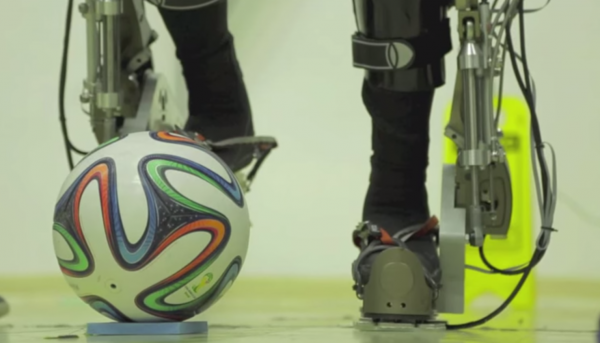FIFA World Cup 2014 Kickoff: Paralyzed Brazilian Teen to Kickoff Opening with Mind Controlled Bionic Exoskeleton

A mind-controlled bionic exoskeleton suit will allow a Brazilian teen, paralyzed in the legs, to stand up out of their wheelchair and make the first kick in the FIFA World Cup 2014 Opening Ceremonies. (Photo : YouTube: UCDavis)
When the FIFA World Cup 2014 in Brazil begins in São Paulo on Thursday, the kickoff of the Opening Ceremony will be something youve literally never seen before: A brain-controlled robotic bionic exoskeleton suit will enable a paraplegic Brazilian teen to get up from his wheelchair and make the ceremonial first kick of the tournament.
The exoskeleton was the brainchild of the Walk Again Project, a collaboration between several universities across the globe including Duke University and the Lily Safra International Institute of Neuroscience of Natal, in Brazil.
The technological miracle of a brain-controlled exoskeleton uses an interface technology developed by Brazilian neuroscientist Dr. Miguel Nicolelis of Duke University, who led the Walk Again Project and who is also credited with building the first mind-controlled arm in the 1990s.
But this time, the success or failure of Nicoleliss mind-controlled bionics will be tested on the biggest, most-watched world stage imaginable.
"We want to galvanize peoples imaginations," said Nicolelis to The Washington Post. "With enough political will and investment, we could make wheelchairs obsolete."
Nicolelis and his team have worked hard not only on the exoskeleton, but in preparation for the Opening Ceremony, so that nothing unexpected happens. As early as March 2014, Nicolelis and his team went to football matches in São Paulo with the suit to make sure cellphone radiation wouldnt interfere with the brain-suit interface. The Brazilian paraplegic teenager -- who has the dual honor of demonstrating a revolutionary technology while kicking off the worlds most popular sporting event -- is one of a group of three possible kickers that will be on deck at the opening ceremonies (the group itself was selected from a group of 10 possible candidates) which have been spending months in a virtual-reality training simulator in preparation.
As for the suit itself, its the result of years of collaboration between scientists and engineers across the globe. The Walk Again Project involves input from the Duke University Center for Neuroengineering, the Technical University of Munich, the Swiss Federal Institute of Technology in Lausanne, the Edmond and Lily Safra International Institute of Neuroscience of Natal in Brazil, The University of California, Davis, The University of Kentucky, and Regis Kopper of The Duke immersive Virtual Environment.
Nicolelis, who has been pioneering brain-machine interfaces for his entire career, worked to build an understanding of how to read brain waves and use them to control robotic limbs and exoskeletons. The lucky kicker will wear a cap fitted with electrodes that pick up their brainwaves, which are routed into the on-board computer worn as a backpack (along with a two-hour battery pack), which will decode the signals and move the hydraulic bionic "muscles" of the exoskeleton -- which the kicker will be strapped into. Nicolelis told The Guardian that the exoskeleton is not clunky or awkward to move.
"The movements are very smooth," said Nicolelis, "They are human movements, not robotic movements." Patients in trials with the exoskeleton agree. "I feel like Im walking on the beach, that Im touching the sand," said one. "This thing was made for me," said another.
The exoskeleton also incorporates gyroscopes to stabilize the exoskeleton, multiple airbags as a redundant safety measure against falls, and sensors on the foot plates, developed in Germany, which will give sensory feedback to the patients arms. It all adds up to a bionic suit that feels like second nature.
"All of the innovations were putting together for this exoskeleton have in mind the goal of transforming it into something that can be used by patients who suffer from a variety of diseases and injuries that cause paralysis," said Nicolelis.
With a successful kickoff on the worlds largest stage, Nicoleliss may be the first -- and possibly, the most spectacular -- goal scored during the FIFA World Cup 2014.
The above story is based on materials by Latin Post.
Note: Materials may be edited for content and length. For further information, please contact the source cited above.
Copyright © 2024 International Society of Bionic Engineering All Rights Reserved
吉ICP备11002416号-1









